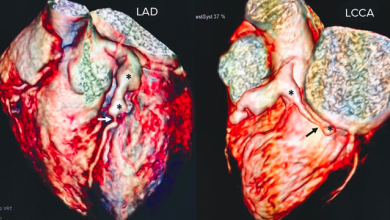Search results
Author(s):
WY Wandy Chan
,
Richard W Troughton
Added:
3 years ago
Acute coronary syndromes (ACS) and acute pulmonary embolism (APE) are leading causes of hospital admission and mortality. Accurate risk stratification is important for both conditions to guide management and the use of therapies that lead to improved outcomes.
Acute Coronary Syndromes
Despite a steady decline in developed countries, ischaemic heart disease is still the leading cause of death…
View more
Author(s):
Alessandro Cavalcanti Lianza
,
Maria de Fátima Rodrigues Diniz
,
Karen Saori Shiraishi Sawamura
,
et al
Added:
8 months ago
Featuring: Dr Patrick Serruys
Author(s):
Patrick W Serruys
Added:
3 years ago
Article
Author(s):
Iskren Garvanski
,
Iana Simova
,
Lazar Angelkov
,
et al
Added:
3 years ago
AF is the most common sustained arrhythmia in clinical routine, and is associated with cardiovascular and cerebrovascular complications, dementia and mortality.1 Pulmonary vein isolation (PVI) in patients with symptomatic AF has become a well-established treatment option.2,3 High acute success rates are achievable, but durable efficacy of previously successful PVIs for AF still remains a…
View more
Histopathological Changes and Clinical Implications in Patients with Hypertrophic Cardiomyopathy
Author(s):
Vibeke Marie Almaas
,
Jan Peder Amlie
Added:
3 years ago
Article
Author(s):
Otto Kamp
,
Gabriel Valocik
Added:
3 years ago
Background
Echocardiography has evolved into the most predominant diagnostic imaging technique in cardiology. Over the last five decades the diagnostic capability of echocardiography has increased dramatically from M-mode to two-dimensional (2-D) imaging. Recent advances in ultrasound instrumentation and computer technology have led to three-dimensional (3-D) echocardiography, introducing a new…
View more
Author(s):
Mauro Chiarito
,
Luca Luceri
,
Angelo Oliva
,
et al
Added:
1 year ago
Author(s):
Konstantinos Bratis
Added:
3 years ago
Takotsubo syndrome (TTS) is an acute, profound, but reversible heart failure syndrome, usually but not always triggered by physical or emotional stress. To date, the exact pathogenic mechanism of this syndrome remains unclear; however, several hypotheses involving vascular mechanisms (i.e. abnormal coronary epicardial or microvascular vasoreactivity),1-3 endocrine and gender-related mechanisms (i…
View more
Author(s):
Giuseppe Gullace
,
Hassan Khalaf
Added:
3 years ago
The endothelium, which was initially considered to be a semipermeable barrier separating lumen from vessel wall, is now recognised as a complex endocrine organ responsible for a variety of physiological processes vital for vascular homeostasis. These include the regulation of vascular tone, luminal diameter and blood flow; haemostasis and thrombolysis; platelet and leucocyte vessel-wall…
View more
Author(s):
David D Daly Jr
,
Michael R Gold
Added:
3 years ago
Interventricular conduction delay is common in patients with systolic heart failure (HF) and has been associated with a poor prognosis amongst these patients.1 Abnormal ventricular depolarization results in prolonged ventricular activation time and increased myocardial tension thus increasing myocardial oxygen consumption and decreasing ventricular diastolic filling time. In addition,…
View more














 « First
« First